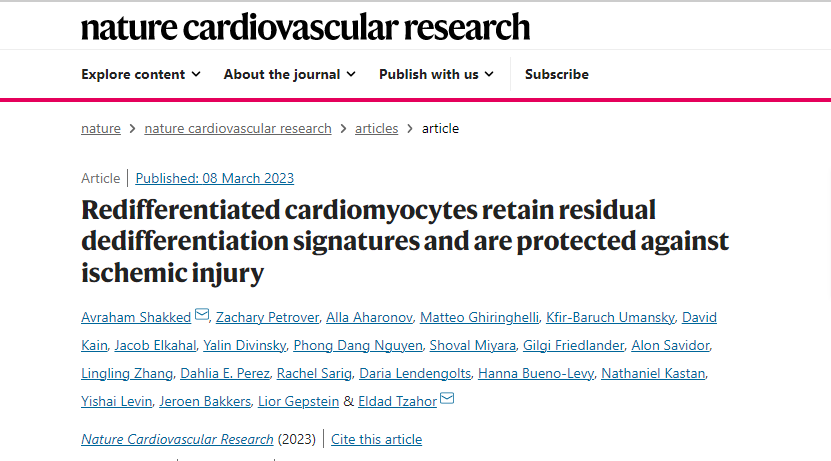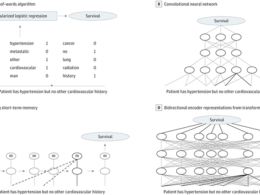the health strategist
research and strategy institute for continuous transformation
in value based health, care and tech
Joaquim Cardoso MSc
Chief Researcher & Editor
March 26, 2023
KEY MESSAGES
- The effects of a heart attack are often permanent, as the heart tissue cannot regenerate, unlike some other tissues.
- This means that despite somebody surviving a heart attack, the damage done could cause health problems or death in the years following the event.
- Regenerating heart tissue to allow damaged heart tissue to be treated is a hot topic in research.
- Now researchers have discovered a mechanism that allows them to treat heart tissue in mice, before a heart attack, in a way that provides protection months later.
DEEP DIVE

Treating heart attack before it happens: It may not be science fiction
Medical News Today
By Hannah Flynn — Fact checked by Jill Seladi-Schulman, Ph.D.
March 20, 2023
Although most people survive a heart attack initially, the risk of death significantly increases over the following years.
In fact, 65% of people who have a heart attack over the age of 65 die within eight years of the initial incident.
This is at least partly because while a person may survive an initial heart attack, the heart attack itself, which leads to the heart tissue being deprived of oxygen and then dying, does not regenerate in adult humans.
In a recent animal study, researchers identified a mechanism that allowed them to treat heart tissue and make healthy mice’s hearts more resilient before a heart attack.
The study’s results appear in Nature Cardiovascular Research.
Prof. James Leiper, Ph.D., Associate Medical Director at the British Heart Foundation and Professor of Molecular Medicine in the School of Cardiovascular and Metabolic Health at the University of Glasgow, U.K. told Medical News Today in an email:
“Most heart attacks are caused by coronary artery disease which can cause your coronary arteries to become narrowed. The narrowing is due to a gradual buildup of fatty deposits called atheroma. If a piece of atheroma breaks off, a blood clot forms around this to try and repair the damage to the artery wall. This clot can then block your coronary arteries causing the heart muscle to be starved of blood, oxygen, and vital nutrients, leading to heart muscle death.
The amount of damage to the heart muscle depends on the size of the area supplied by the blocked artery. As heart muscle is unable to regenerate it never fully repairs. Instead, scar tissue forms in place of healthy cardiac muscle.”
Cardiomyocytes are a type of cell in the heart that is responsible for the contraction of the muscle.
This contraction of the muscle is essential for the heart to be able to squeeze blood around the body, in response to electrical signaling that maintains the heartbeat. When these cells are damaged in a heart attack, the heart loses some of its ability to squeeze blood around the body as effectively.
While cardiomyocytes are able to proliferate in human fetuses, this ability is lost in mature adult humans.
It is believed this is partly due to an evolutionary trade-off that sees the ability of mature cardiomyocytes to proliferate decline with contractile strength. This means damage caused by events such as heart attacks can not be corrected.
The stages of maturation through which cardiomyocytes go from fetal to adult cells are the focus of much research.
Because cardiomyocytes can not proliferate after the damage caused by a heart attack, research has been done on how cardiomyocytes can be dedifferentiated back a stage, to one where they are able to proliferate. Elucidating the mechanisms around this could provide information about how heart tissue damage could be reversed.
However, previous research into dedifferentiated cardiomyocytes has shown that deleterious and lethal effects of irreversible dedifferentiation occur.
This is most likely due to the fact that dedifferentiated cells could become proliferative in a way that is similar to cancer.

It has been hoped that redifferentiation of cardiomyocytes back to the state they were in before differentiation, could avoid some of these complications.
However, it has been unclear if the potential beneficial effects of previous differentiation to a more proliferative state would remain.
Researchers in Dr. Eldad Tzahor’s lab in the Weizmann Institute of Science Molecular Cell Biology Department, previously identified that when a particular protein ERBB2, coded for by the ERBB2 gene was over-expressed, dedifferentiation, occurred.
However, the cardiomyocytes in this dedifferentiated, more proliferative state had a limited ability to contract. Researchers then observed that when overexpression was stopped, the cardiomyocytes underwent redifferentiation and went back to their original contractile ability, and cardiac performance improved.
In the lab’s latest research, led by Dr. Avraham Shakked, Ph.D., they sought to investigate the mechanism behind this gene and protein and the longevity of its effects. They showed that when a transgenic mouse that had its ERBB2 gene temporarily activated at 3 months old had a heart attack 5 months later, it recovered.
This demonstrated that redifferentiated cardiomyocytes maintained some of their proliferative, and therefore healing capacity.
This was the most exciting finding for the team, lead author Dr. Avraham Shakked told MNT in an interview:
“Perhaps the most exciting is the cardioprotective effect of this whole sequence of events that we weren’t really expecting to find or see at all, and actually that has the most potential impact at some point in the future.”
The next steps for the team would involve elucidating the mechanism further.
“One of the things that we’ll do is we’ll actually try and look into the mechanism behind that protection. Because if you can isolate the causative agent with a causative effect, then you don’t necessarily have to undergo a [dedifferentiation and redifferentiation] DR cycle, which could be quite invasive, or quite dramatic.
“If you know exactly what it was then you could probably be a lot more precise in achieving the same result,” he said.
The team had several hypotheses about what could be behind this mechanism and wanted to test them one by one, he said.
Seeing if the findings could be replicated in non-transgenic mice or larger mammals, such as pigs, would be necessary before considering clinical applications in humans, he explained.
Prof. Mauro Giacca, Professor of Cardiovascular Sciences at King’s College London told MNT in an email: “The issue of understanding whether cardiomyocytes return to a physiological, differentiated state after being pushed to proliferate is a key question for clinical cardiac regeneration, and the results obtained by the Tzahor group in their elegant model are quite comforting in this respect. What was less expected is the issue of “rejuvenation” of these cardiomyocytes, which however makes a lot of sense, as replication requires extensive rearrangement of the epigenetic landscape of cardiomyocytes. This is an added bonus to the cardiac regeneration!”
Originally published at https://www.medicalnewstoday.com on March 20, 2023.
ORIGINAL PUBLICATION

Redifferentiated cardiomyocytes retain residual dedifferentiation signatures and are protected against ischemic injury
Nature Cardiovascular Research
Avraham Shakked, Zachary Petrover, Alla Aharonov, Matteo Ghiringhelli, Kfir-Baruch Umansky, David Kain, Jacob Elkahal, Yalin Divinsky, Phong Dang Nguyen, Shoval Miyara, Gilgi Friedlander, Alon Savidor, Lingling Zhang, Dahlia E. Perez, Rachel Sarig, Daria Lendengolts, Hanna Bueno-Levy, Nathaniel Kastan, Yishai Levin, Jeroen Bakkers, Lior Gepstein & Eldad Tzahor
Abstract
Cardiomyocyte proliferation and dedifferentiation have fueled the field of regenerative cardiology in recent years, whereas the reverse process of redifferentiation remains largely unexplored.
Redifferentiation is characterized by the restoration of function lost during dedifferentiation. Previously, we showed that ERBB2-mediated heart regeneration has these two distinct phases: transient dedifferentiation and redifferentiation.
Here we survey the temporal transcriptomic and proteomic landscape of dedifferentiation–redifferentiation in adult mouse hearts and reveal that well-characterized dedifferentiation features largely return to normal, although elements of residual dedifferentiation remain, even after the contractile function is restored.
These hearts appear rejuvenated and show robust resistance to ischemic injury, even 5 months after redifferentiation initiation.
Cardiomyocyte redifferentiation is driven by negative feedback signaling and requires LATS1/2 Hippo pathway activity.
Our data reveal the importance of cardiomyocyte redifferentiation in functional restoration during regeneration but also protection against future insult, in what could lead to a potential prophylactic treatment against ischemic heart disease for at-risk patients.
Originally published at https://www.nature.com/








